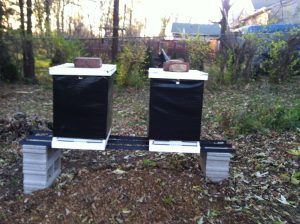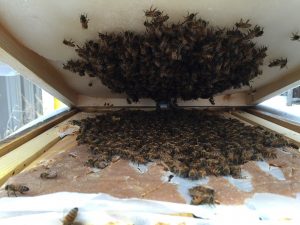Winter in Illinois is becoming more and more unpredictable. After experiencing losing all of our bees due to the harsh winter in years past, we are taking more preventative steps now.
Treating for mites is becoming more and more important. Even though we are using small cell foundation, our bees still seem to harbor a higher than average number of mites. Guidance on the number of mites that is acceptable on a test sample seems to always be in flux depending on the literature read or the person giving the advice. But one trend is for certain, the acceptable number seems to be going down.
Our fall treatment showed mite drop and the bees seemed to be ok after the treatment. On a few of our colonies we think that either the mite treatment was too strong or the mites damaged the hives too much before we treated because a few were lost before the slow was flying. Luckily the rest seem to be in good shape right now.
 We purchased a roll of winter wrap that can be cut into any size depending on the equipment that we are using. This is handy as it will allow us to “wrap up” a stack of ten frame equipment, or a single nucleus colony, or a group of nucleus colonies. We will simply cut what we need. It is also great that the manufacturer claims the product to be reusable for many years.
We purchased a roll of winter wrap that can be cut into any size depending on the equipment that we are using. This is handy as it will allow us to “wrap up” a stack of ten frame equipment, or a single nucleus colony, or a group of nucleus colonies. We will simply cut what we need. It is also great that the manufacturer claims the product to be reusable for many years.
The outer layer is a thick black plastic that absorbs heat and acts as a wind break. The inner layers are foam insulation that will keep the heat in. When it gets cold and windy, this is what our hives need!
We are also placing a notched candy board with an upper entrance on the hive. This will allow humidity, which rises with warm air, to escape out of the hive. Some of the humidity will be absorbed by the candy board and this will make the sugar tasty and readily available for the bees to eat. Our winter wrap covers the sides and up over the top of the candy board. Hopefully this will keep the girls warm and well fed in the winter!
The candy board recipe that we use is the classic one from the Hive and the Honeybee. It is as follows:
15 pounds of white granulated sugar
3 pounds (or one quart) of light corn syrup
1 quart of water
1/2 teaspoon of cream of tartar
We combine all the ingredients into a large pot and stir it with a paint stir on the end of a drill. Once completely combined, heat until it reaches at least 242 F stirring occasionally so it does not burn on the bottom. The heat source should be a strong one. Most kitchen stoves will not produce enough heat to make candy boards in a timely manner. We usually heat until 244 – 246 F but not over 248 F. Let it cool until it is below 200 and then stir it up again and pour it into the candy board container.
W e place our candy boards on the hives and wrap them just before Thanksgiving. Some beekeepers in our area do it just after Thanksgiving or in mid-December. Since bees need to eat and it can get cold and snow in December, we do it early!
e place our candy boards on the hives and wrap them just before Thanksgiving. Some beekeepers in our area do it just after Thanksgiving or in mid-December. Since bees need to eat and it can get cold and snow in December, we do it early!
About mid winter, we place pollen patties to help with buildup. The bees need to stay strong and start rearing new bees for the new year. Then the cycle will continue. I wonder how many mites there are? I wonder how healthy the bees will be? I wonder how much honey the bees will produce?